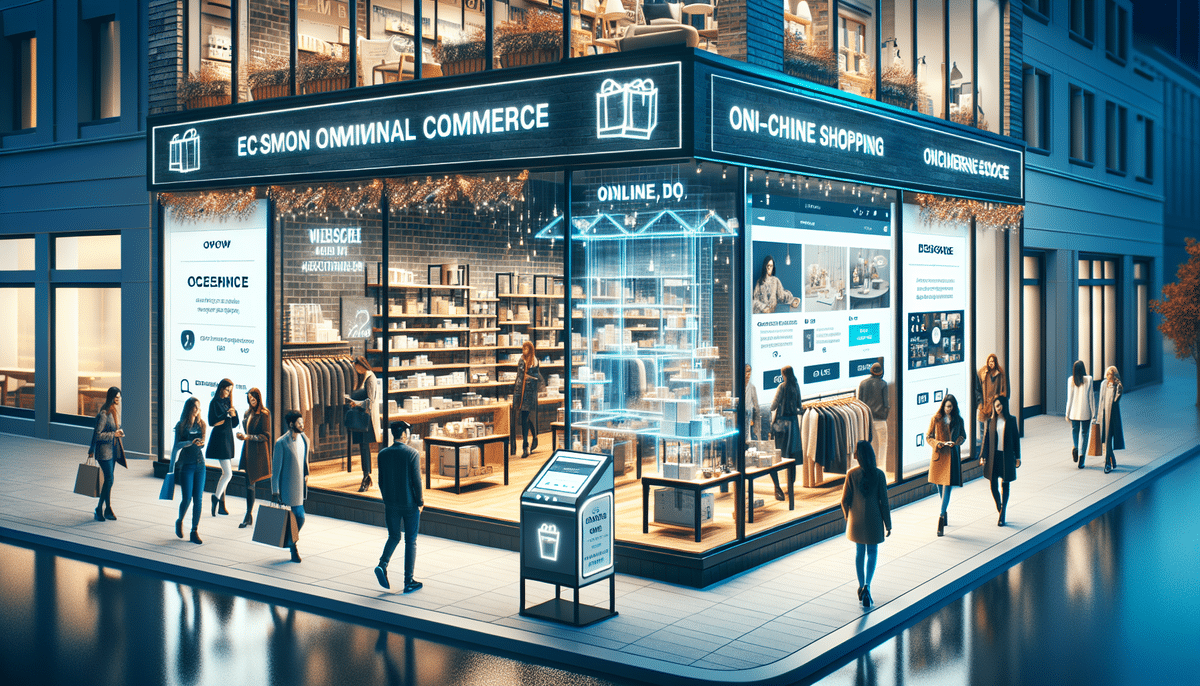How Ecommerce Brands Can Leverage Brick and Mortar to Their Advantage
Online shopping has become the norm for many consumers in recent years. However, brick and mortar stores still play a pivotal role in the retail industry, offering unique advantages that ecommerce brands can capitalize on to enhance their reach, boost revenue, and foster customer loyalty.
Benefits of Integrating Online and Offline Sales Channels
Combining ecommerce with brick and mortar operations provides numerous advantages, including:
- Broader Audience Reach: Offering multiple shopping methods caters to diverse customer preferences, expanding the brand's reach.
- Enhanced Customer Experience: Physical stores provide a tangible and memorable shopping experience. Customers can see, touch, and try products in person, building trust and a deeper connection with the brand.
- Showroom Functionality: Brick and mortar locations can serve as showrooms for products primarily sold online. This allows customers to make more informed purchasing decisions, potentially driving online sales.
- Convenient Fulfillment: Physical stores can act as pick-up and return locations for online orders, streamlining the buying process and increasing customer satisfaction.
- Increased Revenue Streams: More purchasing avenues—whether in-store, online, or a blend of both—provide additional opportunities for sales growth.
According to a Statista report, brick and mortar stores contribute significantly to overall customer satisfaction and retention, with a substantial percentage of consumers expressing a preference for having both online and offline shopping options.
Creating a Seamless Omnichannel Customer Experience
A seamless omnichannel strategy ensures a consistent and cohesive customer experience across all platforms. Key strategies include:
- Integrated Systems: Ensure that online and offline stores are connected, allowing for shared customer data and unified inventory management.
- Technology Utilization: Implement in-store touchscreens for accessing online inventory and reviews, enhancing informed purchasing decisions.
- Location-Based Services: Use geolocation data to send personalized offers and recommendations to customers based on their location.
- Consistent Customer Service: Maintain uniform support standards across all channels, ensuring customers receive the same level of assistance whether shopping online, in-store, or via social media.
According to a study by Forbes, customers who engage with brands across multiple channels tend to spend 3-4 times more than those who stick to a single channel.
Overcoming Challenges of Integrating Online and Offline Operations
While integrating online and offline operations offers significant advantages, it also presents challenges. Ecommerce brands can address these by:
- Inventory Management: Utilize real-time tracking technologies to maintain accurate inventory levels across all channels.
- Brand Consistency: Uphold uniform branding, messaging, and customer service standards both online and in-store to maintain a cohesive brand image.
- Performance Measurement: Track metrics such as in-store and online sales, customer engagement, and satisfaction to evaluate the success of the omnichannel strategy.
- Pricing and Promotions: Implement centralized pricing and promotion management systems to ensure consistency and avoid customer confusion.
- Seamless Customer Journeys: Offer services like buy online, pick up in-store (BOPIS), and in-store returns for online purchases to facilitate smooth transitions between channels.
Implementing solutions like Shopify's inventory management can help streamline operations and overcome these challenges effectively.
Optimizing Brick and Mortar Locations for Ecommerce Success
Choosing the right location is crucial for the success of brick and mortar stores. Key factors to consider include:
- Local Demographics: Understand the target market's characteristics to select a location that aligns with customer profiles.
- Foot Traffic: High-traffic areas increase visibility and potential sales. Retail hubs, shopping malls, and busy streets are ideal options.
- Competition: Analyze the presence of competitors in the area to determine market saturation and opportunities for differentiation.
- Accessibility: Ensure the location is easily accessible by public transport and has ample parking to accommodate customers.
- Economic Health: Research the local economy to gauge consumer spending power and demand for products.
Leveraging geolocation data can also enhance the shopping experience by providing personalized offers based on the customer's proximity to the store.
Leveraging Customer Data for Brick and Mortar Strategies
Effective use of customer data can significantly enhance brick and mortar strategies:
- Data Collection: Gather customer data through online surveys, loyalty programs, and in-store interactions to gain insights into preferences and behaviors.
- Data Analysis: Identify patterns and trends to inform decisions on store layout, product assortment, and promotional activities.
- Personalized Experiences: Use data to offer tailored product recommendations, discounts, and promotions that resonate with individual customers.
- Improved Customer Service: Analyze feedback and complaints to identify areas for improvement, enhancing overall customer satisfaction and loyalty.
According to Harvard Business Review, data-driven strategies can increase customer satisfaction by up to 20%.
Best Practices for Integrating Brick and Mortar into Ecommerce Business Plans
Integrating brick and mortar stores into an ecommerce business plan requires strategic planning and execution. Best practices include:
- Define Clear Objectives: Establish specific goals for the physical store component, such as brand exposure, sales targets, or customer engagement.
- Channel Integration: Ensure seamless integration between online and offline channels, including shared customer data and unified inventory systems.
- Cohesive Branding: Maintain a consistent brand experience across all touchpoints, from online interfaces to in-store environments.
- Invest in Technology: Implement technologies that enhance the in-store experience and streamline operations, such as mobile POS systems or interactive displays.
- Transparent Communication: Keep customers informed about the brick and mortar initiatives through marketing campaigns and clear communication channels.
Adhering to these best practices can facilitate a smooth integration process and maximize the benefits of omnichannel retailing.
Measuring the Success of Omnichannel Strategies
Evaluating the effectiveness of an omnichannel strategy involves assessing various metrics across all channels:
- Sales Metrics: Monitor online and in-store sales, conversion rates, average order value, and sales growth over time.
- Customer Engagement: Track website traffic, email open rates, social media interactions, and in-store foot traffic to gauge engagement levels.
- Customer Feedback: Collect feedback through surveys and reviews to measure customer satisfaction and loyalty.
- Market Position: Conduct competitive analysis and monitor market share to ensure the business remains relevant and competitive.
Tools like Google Analytics and Tableau can aid in tracking and analyzing these metrics effectively.
Case Studies: Successful Integration of Brick and Mortar by Ecommerce Brands
Several ecommerce brands have effectively integrated brick and mortar stores to enhance their business:
- Warby Parker: Initially an online-only eyewear retailer, Warby Parker has expanded to over 100 physical locations, providing customers with the opportunity to try on glasses in person before purchasing.
- Bonobos: Starting as an online men's clothing retailer, Bonobos introduced Guideshops where customers can experience the products in-store and then complete their purchases online.
- Glossier: The beauty brand has opened physical stores to complement its online presence, allowing customers to test products and receive personalized beauty advice.
These brands have successfully merged their online and offline channels to deliver a seamless customer experience and drive sales growth.
Future Trends in the Integration of Online and Offline Sales Channels
The retail landscape continues to evolve, with several emerging trends shaping the future of omnichannel strategies:
- Mobile Technology: Increased use of mobile devices for in-store activities, such as mobile checkout and receiving personalized offers.
- Augmented and Virtual Reality: Implementation of AR and VR technologies to allow customers to virtually try on products before purchasing.
- Social Media Integration: Enhanced integration of social platforms into the shopping experience, enabling purchases directly through social channels.
- Advanced Inventory Management: Continued investment in technologies that optimize inventory tracking and supply chain operations across all channels.
Staying ahead of these trends will enable ecommerce brands to innovate and meet evolving customer expectations effectively.
Balancing Innovation with Tradition: Incorporating New Technology into Brick and Mortar Stores
As ecommerce brands adopt new technologies for their brick and mortar stores, it is essential to balance innovation with traditional retail values:
- Enhancing Experience Without Overcomplicating: Integrate technology in ways that enhance the customer experience without detracting from the personal interactions that make physical stores unique.
- Aligning with Brand Image: Ensure that new technologies complement the brand's identity and support its core values.
- Gradual Implementation: Introduce new technologies incrementally, allowing time for both customers and staff to adjust.
By thoughtfully incorporating technology, brands can elevate the in-store experience while maintaining the quintessential elements that attract customers to brick and mortar locations.
Conclusion
Ecommerce brands can significantly benefit from integrating brick and mortar stores with their online operations. By creating a seamless omnichannel experience, optimizing inventory and supply chain management, and leveraging customer data to inform business decisions, brands can enhance their reach, increase revenue, and build enduring customer loyalty. As technology continues to transform the retail landscape, brands must innovate while preserving the unique qualities that make physical stores invaluable.
For more insights on optimizing your ecommerce strategies, explore resources from reputable industry sources such as Statista, Shopify, or the Harvard Business Review.






















